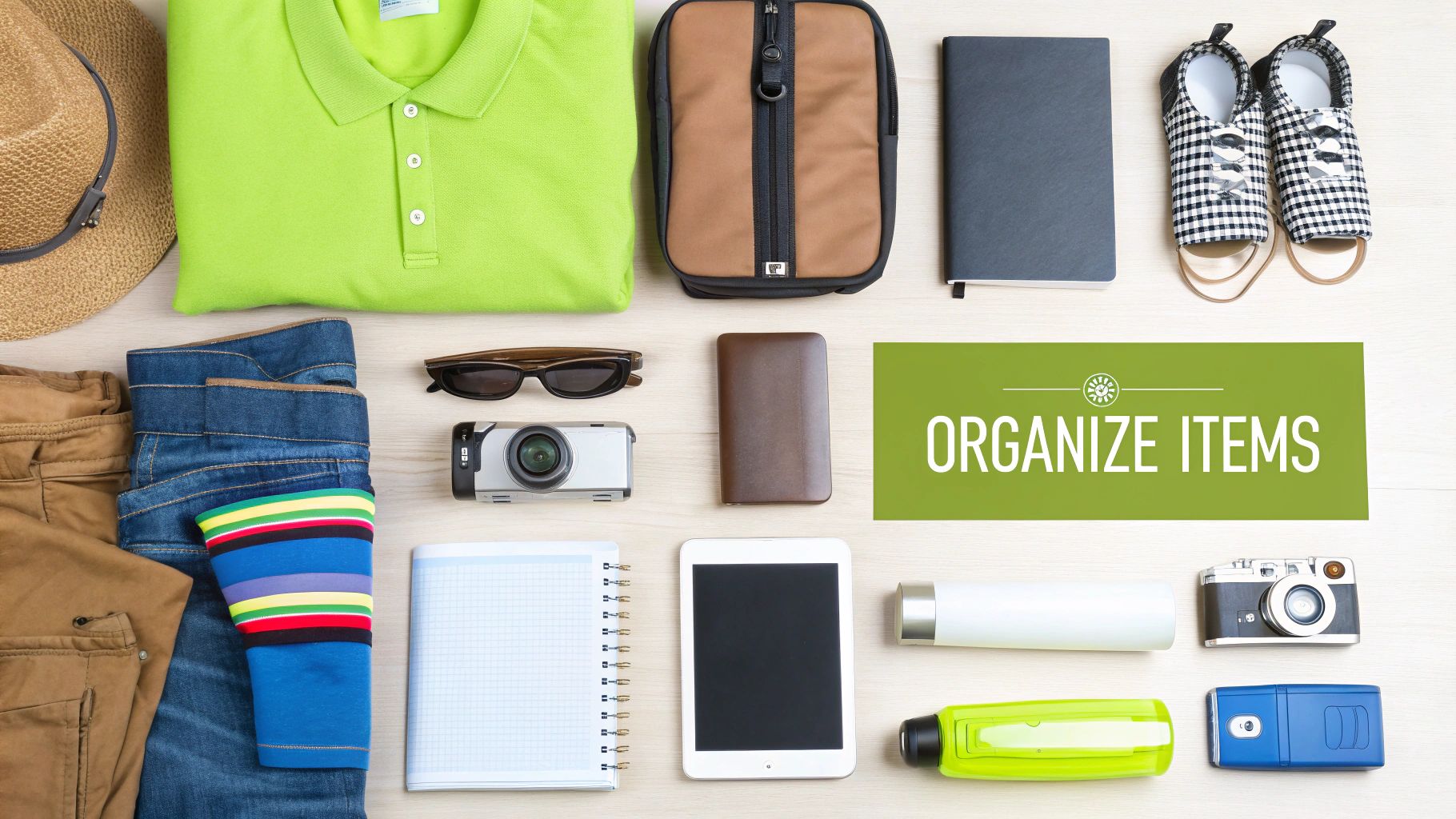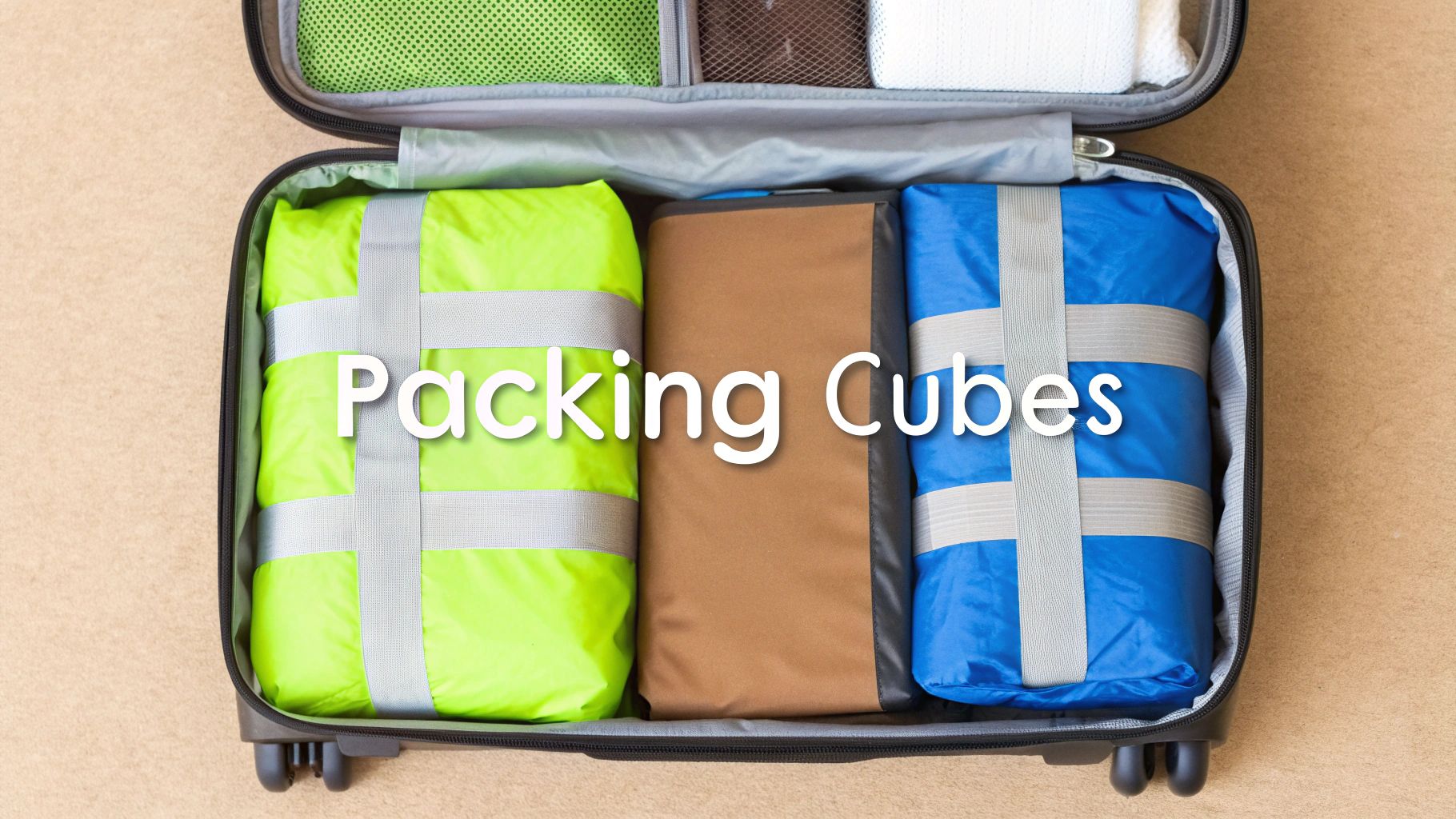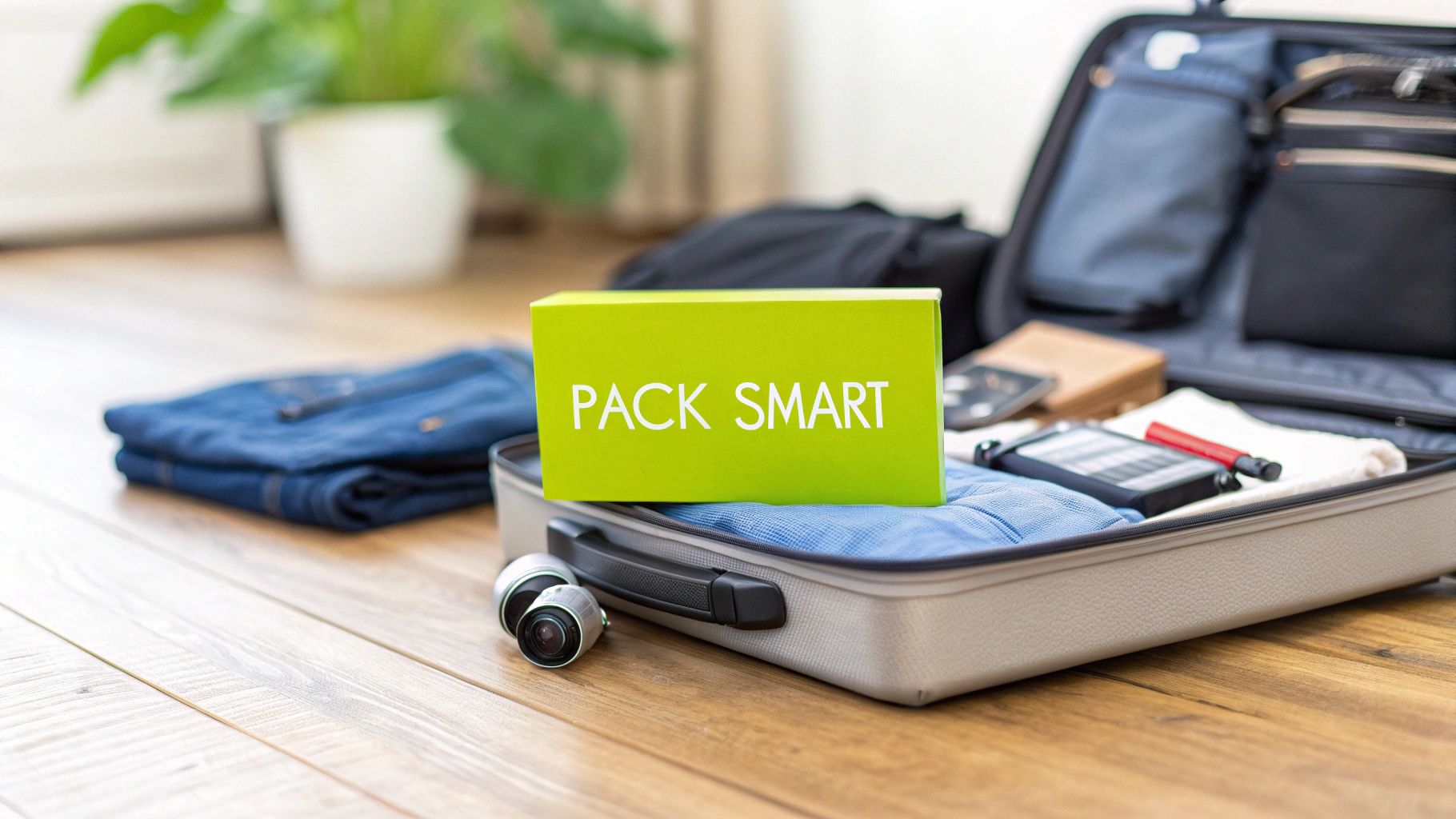The Hidden Science of Space Optimization
Packing efficiently isn't about cramming everything into a confined area. It's a thoughtful process, almost an art, guided by mathematical principles. Think of it as a strategic game of Tetris, where understanding shapes and how they fit together maximizes your score—or, in this case, your space. Logistics professionals use these concepts daily to optimize cargo space, and you can apply them to pack anything, from a suitcase to a moving truck.
Understanding Packing Density
Packing density describes how much of a space is filled. Imagine packing a square box with circles of the same size. The arrangement of those circles dramatically affects how many you can fit. This directly relates to space efficiency. This principle applies to packing oddly shaped clothing into a suitcase, too. Strategic folding and arranging leads to a higher packing density than randomly tossing items in.
Interestingly, the size of the objects being packed influences packing efficiency. Efficient shape packing is a complex mathematical challenge involving arranging shapes without overlap to maximize space usage. Packing same-sized disks into a square provides a good example. Packing 10cm diameter disks into a 1m square results in a packing fraction of about 0.825 (82.5% of the square's area). Using 1cm diameter disks increases this to 0.899 (899%). Smaller items often allow for greater packing density. Explore this fascinating topic further here.
Applying Geometry to Packing
Efficient packing involves understanding the geometry of your belongings and the space you're filling. This goes beyond simply recognizing shapes; it includes considering compressibility. Soft items like clothes compress more than rigid items like electronics. Strategically placing compressible items in squeezable areas allows you to fit more into a bag.
The Power of Preparation
Finally, efficient packing depends on thoughtful preparation. Like an architect planning a building, taking time to categorize and plan your packing strategy significantly impacts the outcome. Analyze the items you need, considering their shapes, sizes, and compressibility. This helps determine the most effective arrangement and saves you time and frustration, making your packing experience smoother and more efficient.
Game-Changing Tools That Transform Your Packing Process
Packing efficiently isn't just about technique; it's about having the right tools. Just as a skilled craftsperson needs a variety of tools, efficient packers rely on a range of supplies to maximize space and minimize hassle. Think of these tools as your packing assistants, each playing a key role in making the entire process smoother.
Compression Bags: Your Space-Saving Allies
Compression bags are incredibly useful, especially for bulky items like sweaters and jackets. These bags allow you to remove excess air, significantly reducing the size of your clothing. However, it's important to remember that not all compression bags are the same. Some require a vacuum cleaner, while others use a simple roll-up design. Choosing the right type depends on your individual needs and available resources. You might be interested in: How to master...
Protective Materials: Beyond Bubble Wrap
Protecting fragile items is essential. While bubble wrap is a tried-and-true classic, consider other options like foam sheets and padded pouches, which offer excellent protection and are often more compact. Don't forget to use clothing as padding. Wrapping breakables in sweaters or socks provides cushioning while also making the most of the space taken up by your clothes.
Unexpected Household Items: Repurposing for Packing
Thinking outside the box can make a real difference in your packing process. Shower caps are perfect for covering shoe soles and preventing them from dirtying your clothes. Pill organizers are great for storing small jewelry items, keeping them organized and tangle-free. Repurposing everyday items like these not only saves you money but also reduces waste.
Premium vs. Budget-Friendly: Finding the Right Balance
Some packing tools can be expensive. While packing cubes offer convenient organization, zip-top bags provide a similar function at a fraction of the cost. When deciding between premium and budget-friendly options, think about how frequently you pack and your overall budget.
Sustainability: Packing with the Planet in Mind
More and more, people are prioritizing sustainability when they pack. Reusable compression bags and eco-friendly packing materials are becoming increasingly common. This helps reduce waste and aligns with environmentally conscious travel practices. In the larger context of packaging, the global market is predicted to grow at a CAGR of 3.94% from 2022 to 2027. The flexible packaging market is expanding even faster at a CAGR of 4.82%, reflecting a significant shift in consumer preferences and industry trends. For more detailed statistics, check out this resource: Packaging Statistics. These trends highlight the growing importance of smart and sustainable packing solutions.

By strategically selecting and using these helpful tools, you can transform packing from a chaotic chore into a smooth and efficient process. This saves you time, space, and stress, and sets the stage for the next step: categorizing your belongings effectively.
The Item Categorization Method Professional Organizers Use

Professional organizers have a secret to their packing prowess: efficient categorization systems. These systems transform messy piles into organized groups, setting the stage for a smooth packing experience. This pre-packing step ensures you pack what you need and easily find it later.
Categorizing By Usage Frequency
Think about how often you'll need items during your trip or after moving. Essential items, like toiletries and medications, should be packed last or in a separate, easy-to-reach bag. This avoids digging through your suitcase for your toothbrush. Less frequently used items can be packed first and deeper within your luggage.
Sorting By Fragility
Fragile items need extra care. Group them together and use suitable protection. Packing these strategically within your bag, ideally in the center surrounded by softer items, minimizes breakage risk. This protects valuable belongings during travel.
Considering Weight and Bulk
Weight distribution is essential, especially for larger bags and boxes. Pack heavier items at the bottom to prevent crushing lighter objects. Grouping similar-weight items makes lifting and moving easier. This is vital for moves, where uneven weight distribution makes boxes awkward. For more tips on weight management, see our guide on How to master....
Accessibility and Unpacking
Consider the order you'll need things at your destination. For multi-city trips, pack clothes for the first leg in an easily accessible compartment. This avoids unpacking your entire bag at each stop. For instance, pack summer clothes near the top if you're heading to a warm climate first.
Adapting Categorization to Different Scenarios
These categorization principles apply to any packing situation, from weekend trips to household moves. For business trips, keep work essentials separate and accessible. For camping trips, categorize by activity: cooking gear, sleeping gear, hiking gear. This adaptable approach keeps you organized, no matter the situation.
To help visualize this process, let's take a look at a sample categorization system:
This table presents a sample categorization system to streamline your packing process:
| Category | Description | Packing Priority | Container Type |
|---|---|---|---|
| Clothing | Shirts, pants, dresses, etc. | Medium | Suitcase/Box |
| Toiletries | Shampoo, soap, toothbrush, etc. | High | Carry-on/Small Box |
| Electronics | Laptop, phone, charger, etc. | High | Carry-on/Protected Box |
| Documents | Passport, tickets, important papers, etc. | High | Carry-on/Secure Folder |
| Books & Media | Books, magazines, DVDs, etc. | Low | Suitcase/Box |
| Valuables | Jewelry, cash, sentimental items, etc. | High | Carry-on/Secure Pouch |
| First-Aid | Bandages, pain relievers, antiseptic wipes, etc. | High | Carry-on/Small Box |
| Miscellaneous | Any other items not fitting other categories | Low | Suitcase/Box |
This table provides a framework for thinking about your belongings and how to best organize them for packing. Remember to adapt it based on your specific needs and the type of trip or move you are undertaking.
Using these methods saves you time, reduces stress, and makes packing more efficient. By organizing from the start, you create a foundation for optimal packing and effortless unpacking. This strategic pre-sorting simplifies packing and reduces overwhelm.
Folding vs. Rolling: Space-Saving Techniques That Actually Work

The eternal question for travelers: folding or rolling? Which method truly saves the most space? The answer, it turns out, isn't so simple. It depends on what you're packing and your personal preference. Let's dive into these space-saving techniques and help you prepare for your next trip.
The Military Roll: A Space-Saving Champion
The military roll, a favorite of service members, is incredibly effective for maximizing space and minimizing wrinkles. It involves tightly rolling clothing into compact cylinders. This method works wonders for items like t-shirts, pants, and underwear.
Think about packing for a backpacking trip. Every single inch of space matters. The military roll can be a lifesaver in these situations, allowing you to fit more into a smaller bag.
File Folding: Maintaining Visibility and Order
File folding takes a different approach, creating a layered system inside your luggage. Items are folded flat and stacked vertically, like files in a cabinet. This makes it easy to see everything at a glance, so you can grab what you need without unpacking your entire bag.
File folding is especially useful for dress shirts, sweaters, and other items prone to wrinkling.
Bundle Wrapping: Wrinkle-Free Travel
The bundle wrapping technique prioritizes wrinkle prevention. Clothes are wrapped around a central core, often a pouch of smaller items. This creates a protective layer that prevents clothes from shifting and wrinkling during travel.
Want to learn more? Check out this resource: How to master...
Tailoring Your Technique
The best packing strategy depends on the situation and the specific items you're packing. Rolling works great for casual clothes, while folding might be better for formal wear.
Efficient packing isn’t just for personal travel, either. It's essential in industries like logistics and manufacturing. Descriptive statistics help analyze packaging data and identify areas for improvement. This data helps optimize packaging and improve efficiency across many fields.
To illustrate the differences in space efficiency, let's look at a comparison of folding versus rolling:
Folding vs. Rolling: Space Efficiency Comparison Comparing different packing techniques for common clothing items
| Clothing Item | Traditional Folding (cu. in.) | Rolling Method (cu. in.) | Space Savings (%) |
|---|---|---|---|
| T-Shirt | 48 | 32 | 33 |
| Jeans | 120 | 96 | 20 |
| Dress Shirt | 72 | 60 | 17 |
| Sweater | 192 | 144 | 25 |
This table shows that rolling can save significant space, especially for bulkier items like sweaters and t-shirts. While the savings may be less dramatic for items like jeans and dress shirts, every bit counts when you're trying to pack light.
Combining Techniques for Ultimate Efficiency
The most effective approach often involves a combination of techniques. You might roll t-shirts and underwear, file fold dress shirts, and bundle wrap delicate items.
This personalized approach maximizes space and minimizes wrinkles, creating a highly efficient packing system. Different luggage types also call for different strategies. Experiment to find what works best for you.
Strategic Placement: The Weight Distribution Secret

Have you ever noticed how effortless it is to wheel a professionally packed suitcase? It glides smoothly, feeling balanced and manageable. Contrast that with your own luggage, often a chaotic jumble that feels like it might tip over at any moment. The key difference lies in strategic weight distribution. This same principle, used by logistics professionals worldwide, can completely change how you pack and handle your belongings.
Mastering the Heavy-to-Light Technique
Think about loading a backpack with books. Placing the heaviest volumes on top creates an unstable, top-heavy load. This principle applies universally to packing any container. The heavy-to-light technique builds a stable foundation and safeguards delicate items.
Start by placing the heaviest items at the bottom of your suitcase. Shoes and books are good examples. Gradually layer lighter items on top, progressing to clothing and finally, toiletries. This method not only protects fragile items but also makes lifting and maneuvering significantly easier.
Utilizing Odd-Shaped Gaps: Finding Hidden Space
Efficient packing involves maximizing every bit of available space. Traditional packing methods often leave odd-shaped gaps unused. However, these spaces represent hidden storage potential waiting to be unlocked. Approach your suitcase like a three-dimensional puzzle.
Roll socks and underwear to fill the gaps between larger items. Tuck smaller belongings inside shoes to save space and help them retain their shape. This strategy maximizes the packing density, allowing you to fit more into the same container.
Prioritizing Accessibility: The Psychology of Packing
Efficient packing isn't solely about maximizing space; it's also about accessibility. Consider the items you'll need most frequently and pack them strategically. Items needed during travel, like medications or snacks, should be placed in an easily accessible outer pocket. This saves you the hassle of unpacking your entire bag to retrieve essential items.
Similarly, when unpacking at your destination, place frequently used items in easily reachable drawers or shelves. This mindful approach streamlines both the packing and unpacking process. For instance, if you're on a trip with multiple stops, pack outfits for your first destination at the top of your suitcase.
The Impact of Weight Distribution on Handling
Strategic weight distribution significantly improves the handling experience. A well-balanced suitcase or backpack is noticeably easier to lift, carry, and maneuver, especially crucial when dealing with heavy luggage or navigating crowded areas and stairs. Even weight distribution minimizes strain on your back and shoulders, enhancing travel comfort.
The same principle applies to moving boxes. Evenly distributed weight facilitates stacking and transport, reducing the risk of injury. Furthermore, percentages are commonly used in packaging statistics to provide clear and comparable metrics, particularly in small-sample research where confidence intervals are important for decision-making. Learn more about this here. By implementing these strategic placement techniques, you can transform packing from a chore into a more efficient and stress-free experience.
Scenario-Specific Techniques: Adapt Like a Pro
Packing efficiently isn't one-size-fits-all. Just as experienced travelers adjust to new cultures, your packing strategy should evolve with each trip. Whether it's a business trip, an extended vacation, a cross-country move, or even an emergency evacuation, tailoring your approach is key.
Business Travel: Wrinkle-Free and Ready to Go
Business travel requires efficiency and a professional image. Your packing should reflect this. Use garment bags for suits and dresses to minimize wrinkles. Rolling shirts and trousers saves space and prevents creases. Protect your clothing from dirty shoes by using shoe bags. Keep important documents and electronics in a separate, readily accessible compartment.
Extended Vacations: Maximizing Space and Minimizing Baggage Fees
Extended vacations pose the challenge of packing more while staying within airline weight limits. Compression bags are essential for bulky items like sweaters and jackets. Bundling or the KonMari folding method can maximize space. Consider doing laundry at your destination to pack less.
Cross-Country Moves: Protecting Valuables and Streamlining the Process
Moving across the country requires a different mindset. Protecting valuables takes priority. Wrap fragile items carefully in packing paper or bubble wrap. Use sturdy boxes and label them clearly. Disassembling furniture, when possible, and keeping all hardware together in labeled bags is recommended. Color-coding boxes by room can streamline unpacking.
Emergency Evacuations: Prioritizing Essentials and Speed
In emergencies, packing efficiently is crucial. Focus on essential documents, medications, and a few changes of clothing. A readily available "go-bag" with these items allows for quick evacuation.
Adapting Fundamentals Across Contexts
While each scenario has unique demands, the core principles of efficient packing remain consistent:
-
Space Optimization: Maximizing space is paramount, whether packing a suitcase or a moving truck.
-
Weight Distribution: Proper weight distribution is essential for easy handling, from backpacks to shipping containers.
-
Item Categorization: Organizing by category simplifies packing and unpacking in any situation.
-
Choosing the Right Tools: The right tools, from compression bags to sturdy boxes, make the process smoother.
By mastering these principles and adapting them to specific needs, you can confidently handle any packing challenge. Remember, the goal is to pack smart, not just light.
Ready to improve your packing and experience the freedom of efficient travel? Discover the Titantrek vacuum compression backpack at https://titantrekstore.com. With its unique compression system and durable design, the Titantrek backpack is ideal for any adventure.

5 Ways to Protect Your Gear While Traveling
Ultimate Guide to Choosing a Travel Backpack